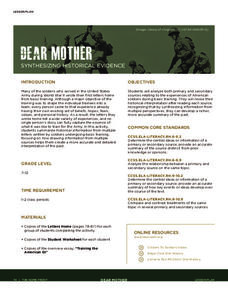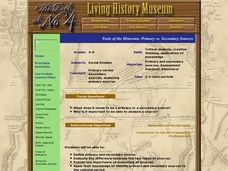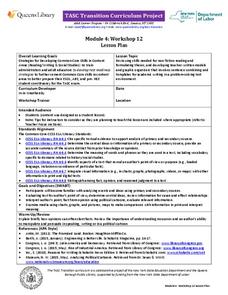National WWII Museum
On Leave in Paris: Maps as Primary Sources
Primary sources—even those that seem mundane—offer a window into those who experienced history. Using a Red Cross map offered to soldiers stationed in Paris after World War II alongside worksheet questions, scholars consider what life...
National WWII Museum
Dear Mother: Synthesizing Historical Evidence
It's one thing to read history, it's another to live it. Pupils examine secondary and primary sources that detail the training of soldiers before deployment. Then, they consider the impact of primary sources on how they understand the...
PBS
Using Primary Sources: The Rogue's Gallery
What would be in your life's scrapbook? Scholars use short video clips, primary and secondary documents, and photos to investigate a 1909 scrapbook. They analyze and uncover what the Rogue Book tells them about the past in Western...
Canadian War Museum
Comparing Primary and Secondary Sources
This simple two-day lesson introduces learners to the differences between primary and secondary sources. The lesson includes group work that explores the similarities and differences, and the advantages and disadvantages of primary...
K20 LEARN
Blue or Gray? Perspectives on the Civil War
Using primary and secondary sources, such as letters and diaries from soldiers and civilians, learners consider why people fought in the American Civil War. A role-playing Historical Mingle activity, as well as discussion questions and...
TPS Journal
Sourcing a Document: The First Thanksgiving
How reliable is a painting of the first Thanksgiving if it was created 300 years after the fact? Learners assess the validity of a primary source image to determine what it can actually reveal about this event.
Mr. Roughton
Cold Case Rome
Pupils are transformed into detectives in the case to solve the motive behind the assassination of Julius Caesar. This resource includes eight engaging "exhibits" of unique primary and secondary sources for students to analyze...
PBS
Primary Sources
Students see how to use primary and secondary sources to investigate history. Whether it is a photograph, book, map, letter, postcard, newspaper, or official document, students can use sources to reconstruct and relive history.
Curated OER
The Crittenden Conway Duel
Students explore primary and secondary sources. In this primary and secondary source lesson, students investigate a crime scene. Students search for evidence around the classroom and evaluate their findings. Students write a crime report...
Curated OER
Recreation Yesterday and Today
Eleventh graders research entertainment and recreation in the early 20th century using the American Memory collections and From the Hidewood: Memories of a Dakota Neighborhood, a book by Robert Amerson reflecting life in Deuel County,...
Curated OER
Slavery in America at the Time of the Civil War: Sources
Students discover how to use primary and secondary sources in research. For this Civil War lesson, students conduct research on slavery as they distinguish between primary and secondary sources regarding the same events.
Curated OER
Understanding Clues from the Past: School Days
Third graders read primary and secondary sources as the study about schools in the early years of Kansas. In this primary and secondary source lesson, 3rd graders examine how historians use primary source documents to tell about the past...
Curated OER
African American Experiences: Window to the Past
Students examine African life during slavery on the Internet. In this slavery lesson, students use the Internet to research slavery and create a scrapbook. Students review pictures of slavery and label them as primary or secondary sources.
Curated OER
Runaway Ads
Fourth graders distinguish between primary and secondary sources while creating an underground railroad presentation. In this underground railroad lesson, 4th graders research the underground railroad using copies of primary and...
Curated OER
Signature History
Students review the meaning and application of primary and secondary sources in research. They determine how researchers locate primary source documents before looking at signatures as a validating factor on many primary sources....
Curated OER
My Story and History: Peeking into the Past with Paintings
Consider how you can use a visual source, such as a painting, to learn about a historical time or event. Young learners discuss primary sources and how they differ from secondary sources, then analyze the painting Mother and Child by...
History with Peters
A Clear Signal for Change: Multiple Interpretations and Nat Turner’s Rebellion
Was Nat Turner a hero or a violent criminal? Using primary sources and images that discuss the rebellion of enslaved people he led in antebellum Virginia, scholars consider the question. Then, they create memorials to Turner and...
Houston Independent School District
Creating a Successful Project
Guide your learners step by step through the process of designing an original, independent student project. This resource includes a wealth of worksheets and materials, including student project checklists, timelines, primary and...
Curated OER
Tools of the Historian: Primary vs. Secondary Sources
Students identify the difference between primary and secondary sources. They discuss the importance of evaluating all sources they might use. They read primary and secondary sources that relate to the colonial period.
Curated OER
Sources of Information
In this sources of information worksheet, middle schoolers respond to 7 fill in the blank questions regarding primary and secondary sources.
Library of Congress
Determining Point of View: Paul Revere and the Boston Massacre
If you're teaching point of view, this is the lesson plan for you! First, decipher the writer's point of view from a primary resource, then compare and contrast the primary source with a secondary source to explore the Paul Revere's...
K20 Learn
Bavaria Has Issues...Experimental Components
Do you want to be a detective by analyzing situations? An engaging lesson provides young historians with the tools to help them understand the difference between data types and how to analyze them to draw conclusions. Scholars complete...
EngageNY
TASC Transition Curriculum: Workshop 12
How can opinions slant facts? Workshop participants learn how to examine primary and secondary sources and identify the author's point of view. They also examine how visual art impacts the meaning and rhetoric of sources. Full of...
Mr. Roughton
The Travels of Marco Polo
Were the stories of Marco Polo's travels and interactions with the Mongols actually true? Using an excerpt from the book The Travels of Marco Polo, your young historians will answer guiding questions to discuss the accuracy and...

























